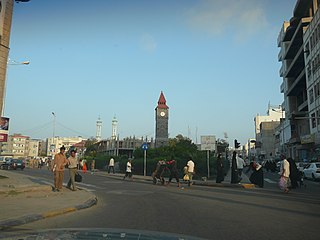
Aden is a port city located in the southern part of the Arabian peninsula, positioned near the eastern approach to the Red Sea. It is situated approximately 170 km east of the Bab-el-Mandeb strait and north of the Gulf of Aden. With its strategic location on the coastline, Aden serves as a gateway between the Red Sea and the Arabian Sea, making it a crucial maritime hub connecting Africa, Asia, and the Middle East. As of 2023, Aden City has a population of approximately 1,080,000 residents, making it one of the largest cities in Yemen.

South Yemen (Arabic: اليمن الجنوبي, romanized: al-Yaman al-Janubiyy), officially the People's Democratic Republic of Yemen (جمهورية اليمن الديمقراطية الشعبية, Jumhūriyat al-Yaman al-Dīmuqrāṭīyah al-Sha'bīyah), also referred to as Democratic Yemen (اليمن الديمقراطي, al-Yaman al-Dīmuqrāṭīyy) or Yemen (Aden) (اليمن (عدن), al-Yaman ('Adin)), was a communist state that existed from 1967 to 1990 as a state in the Middle East in the southern and eastern provinces of the present-day Republic of Yemen, including the island of Socotra.

The Federation of South Arabia (FSA) was a federal state under British protection in what would become South Yemen. Its capital was Aden.

Perim, also called Mayyun in Arabic, is a volcanic island in the Strait of Mandeb at the south entrance into the Red Sea, off the south-west coast of Yemen and belonging to Yemen. It administratively belongs to Dhubab District or Bab al-Mandab District, Taiz Governorate. The island of Perim divides the strait of Mandeb into two channels.

The Aden Protectorate was a British protectorate in South Arabia which evolved in the hinterland of the port of Aden and in the Hadhramaut following the conquest of Aden by the Bombay Presidency of British India in 1839, and which continued until the 1960s. In 1940, it was divided for administrative purposes into the Western Protectorate and the Eastern Protectorate. Today, the territory forms part of the Republic of Yemen.

Aden Colony, also the Colony of Aden, was a British Crown colony from 1937 to 1963 located in the south of contemporary Yemen. It consisted of the port of Aden and its immediate surroundings.

The State of Aden was a state constituted in Aden within the Federation of South Arabia. Following its establishment on 18 January 1963, Sir Charles Johnston stepped down as the last Governor of Aden.

Lahej, the Sultanate of Lahej, or, sometimes, the Abdali Sultanate, was a Sheikdom based in Lahij in Southern Arabia. The Sultanate became self-ruling in 1728 and gained independence in 1740. In 1839, the Sultanate became part of the Aden Protectorate of the British Empire, though nominally the 'Abdali Sultan retained his status. The Aden Protectorate was briefly ruled again by the Ottomans during World War I, but regained by the British and absorbed into Federation of South Arabia in 1963. The 'Abdali dynasty was officially abolished in 1967, with the proclamation of South Yemen.

The Federation of the Emirates of the South was an organization of states within the British Aden Protectorate in what would become South Yemen. The Federation of six states was inaugurated in the British Colony of Aden on 11 February 1959, and the Federation and Britain signed a “Treaty of Friendship and Protection,” which detailed plans for British financial and military assistance. It subsequently added nine states and, on 4 April 1962, became known as the Federation of South Arabia. This was joined by the Aden Colony on 18 January 1963.

Aden is a city in southern Yemen. Aden's location made it a popular exchange port for mail passing between places around the Indian Ocean and Europe. When Captain S. B. Haines of the Indian Marine, the East India Company's navy, occupied Aden on 19 January 1839, mail services were immediately established in the settlement with a complement of two postal clerks and four letter carriers. An interim postmaster was appointed as early as June 1839. Mail is known to exist from 15 June 1839 although a regular postmaster was not appointed until 1857; one of the officials of the Political Agent or the civil surgeon performed the duties of postmaster for a small salary.
The modern history of Yemen began with the withdrawal of the Ottoman Empire. In 1839 the British set up a protective area around the southern port of Aden and in 1918 the northern Kingdom of Yemen gained independence from the Ottoman Empire. North Yemen became a republic in 1962, but it was not until 1967 that the British Empire withdrew from what became South Yemen. In 1970, the southern government adopted a communist governmental system. The two countries were formally united as the Republic of Yemen on May 22, 1990.

The Aden Emergency, also known as the Radfan Uprising, was an armed rebellion by the National Liberation Front (NLF) and the Front for the Liberation of Occupied South Yemen (FLOSY) against the Federation of South Arabia, a British Protectorate of the United Kingdom, which led to the proclamation of the People's Republic of South Yemen.
This is a survey of the postage stamps and postal history of Yemen.

The National Liberation Front was a Marxist paramilitary organization and a political party operating in the Federation of South Arabia, during the Aden Emergency. During the North Yemen Civil War, fighting spilled over into South Yemen as the British attempted to establish an autonomous colony known as the Federation of South Arabia. Following the exit of the British armed forces, the NLF seized power from its rival, the Arab nationalist Front for the Liberation of Occupied South Yemen (FLOSY). In the aftermath of the Emergency, the NLF reorganized itself into the Yemeni Socialist Party and established a single-party Marxist-Leninist government, known as the People's Democratic Republic of Yemen.

The Aden riots of December 2–4, 1947 primarily targeted the Jewish community in the British Colony of Aden. The riots broke out from a planned three-day Arab general strike in protest of United Nations General Assembly Resolution 181 (II), which created a partition plan for Palestine. The riots resulted in the deaths of 82 Jews, 33 Arabs, 4 Muslim Indians, and one Somali, as well as wide-scale devastation of the local Jewish community of Aden. The Aden Protectorate Levies, a military force of local Arab-Muslim recruits dispatched by the British governor Reginald Champion to quell the riots, were responsible for much of the killing.

Big Ben Aden is a clock tower built by British engineers, along with locals, beside Aden Harbour in Yemen during the period that Aden Province was a territory within the British Empire. It is superficially similar to the Elizabeth Tower, the famous clock tower attached to the Palace of Westminster in London. The clock was shut down for renovation about a quarter of a century ago, and returned to service in February 2012. The tower was built during the 19th century as part of the British colonisation of Aden Province, which began in 1839 and came to an end in 1967.
The Arab Police mutiny was an incident during the Aden Emergency where Arab soldiers and police mutinied against British troops. While the mutiny itself was localized and quickly suppressed, it undermined the South Arabian Federation which had been organized by Britain in 1959 as an intended successor to direct colonial rule.

The Chief Commissioner's Province of Aden was the administrative status under which the former Aden Settlement (1839–1932) was placed from 1932 to 1937. Under that new status, the Viceroy of India assumed direct control over Aden, which had hitherto been administered by the government of the Bombay Presidency. The Aden Protectorate remained unaffected by this change.
The following is a timeline of the history of the city of Aden, Yemen.

The Oman–Yemen border is 294 km (183 mi) in length and runs from the tripoint with Saudi Arabia in the north to the Arabian Sea in the south.



























